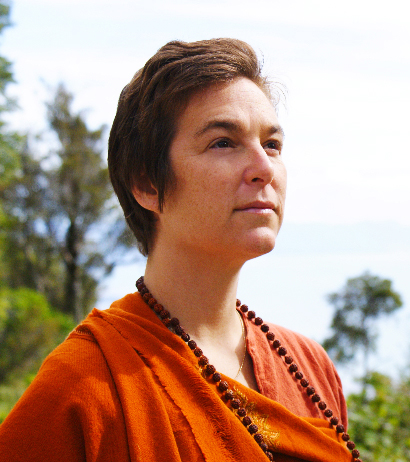by Swami Karma Karuna: We are currently living through a time that has thrown the ‘norm’ out the door and despite the challenges for many, it is also a wakeup call, an opportunity to think about our lives and take stock…
Jnana yoga is a process of sincere self-inquiry with the aim of finding true inner wisdom. Whilst the physical practices of yoga continue to be important, looking in and connecting to the inner voice is taking on a life of its own. In Jnana Yoga, the mind is used to question its own nature, and to go beyond the illusions and identification with the body, thoughts and ego to connect with the deepest source. Jnana Yoga is closely linked with the process of meditation and particularly the development of mindfulness or witness awareness, which is used to reflect back on our actions and thoughts with the aim of gaining deeper self-understanding.
Learning to witness or be the non-judgmental observer of whatever occurs at the different layers of experience is an important key to becoming free from the influence of past conditioning, impressions, traumas and inner material that influences the current life experience.
In our daily life, we are almost always externalized, relating to life with the five senses. The inputs through the ears, eyes, hands, nose, and mouth ignite different mental states, projections in the future, reinforcing attachments, likes, dislikes and forming a robust trap for the mind. The practices of Jnana Yoga provides tools to help the practitioner become free from the constrictions of the lower mind.
The meditation of Antar Mouna is a mindfulness-based practice that gradually leads the practitioner inwards to develop the witness. It has three stages; witnessing the sensorial inputs and becoming more immune to them. For example, feeling less disturbed by external noise or more aware of how the smell of that fresh-baked bread, triggers you to eat when you are not hungry. The second stage allows you to be the observer of thoughts and emotions and the more subtle layer of experience. It is like standing on the railway platform, watching the thought trains go by and using awareness to stop you jumping on the train. You become the observer to whatever unfolds internally without reaction. The third stage gives one the skills to jump on a particular chosen thought train and consciously explore all the corners of the chosen thought or emotion to understand the roots.
Over time, Antar Mouna helps one to understand the workings of one’s own rational and irrational mind. When practised regularly, an attitude of the non-attached observer underlies all experiences, actions and thoughts. It shows you who you are and gives you an opportunity to be more conscious in everyday life. The essence of the technique is acceptance and respect for the mind, and the ability to remain an impartial witness to all its manifestations.
Learning to witness and become the observer is also inherent in two important yogic principles which allow us to understand ourselves more deeply.
Knowledge and Non-attachment
Viveka: Translated as knowledge or wisdom, this is a quality that allows one to know what is conducive and what is destructive for their own expansion. In viveka one enquires with total sincerity, learning to discriminate between the self and the non-self, between the permanent and the impermanent. A person full of viveka asks questions not to satisfy the mind, but rather from an incomplete heart, searching for completeness.
Vairagya: A sense of non-attachment to the objects, people and experiences that create pain or pleasure in life. This is not to be misunderstood as irresponsibility and inability to connect or love, but is rather a quality based on interacting with life fully, but without the attachment to it. In the same way that a banker is not attached to the money that goes through her hands each day because it does not belong to her personally, one has to live life fully but release the idea of ownership and identification with objects and people. Without vairagya, we cannot go beyond the deep mental patterns. In the Bhagavad-Gita, vairagya is described as a sharp instrument needed to cut through the attachments.
SWAN Technique
With the tools of witness, viveka and vairagya, one can really begin to explore themselves. The self-enquiry and self-analysis tool called SWAN practice, developed by Swami Niranjanananda, is an acronym for Strengths, Weaknesses, Ambitions and Needs. Through deeply reflecting on each of these aspects over time, we come to know and understand ourselves objectively. SWAN takes us on a journey of self-exploration, allowing us to examine our own nature, to accept ourselves for the person that we are without judgement, and to work towards transformation.
SWAN sadhana is a way to realise our dormant potential. If we do not accept ourselves, we create disharmony. When we attain self-acceptance, we can transform weaknesses into strengths and give energy to manifesting dormant strengths. Over time, we learn to decipher what we really need as compared to what we want. We can also redirect our ambitions in positive ways, so that they are expressed in a way that enhances our spiritual development.
Often, we perceive that it is a situation or person that blocks us, but when we look deeply into the mind, we see that we block ourselves. In the process of reprogramming the mind, the ego will try to stop us by grasping onto its power or perhaps creating needs and desires. These needs and desires stem from the unconscious mind which stores patterns and traumas often created in childhood. It also seeds many desires and ambitions that arise, some of which may be positive and helpful in life and others may be taking us down a destructive path or away from what we really want in our lives. The process of SWAN gives us clarity within ourselves to express our best qualities, transform weaknesses, direct ambitions with awareness and honour our real needs.
Begin with a short brainstorm using the below categories as a guide and write down whatever comes to mind in each area. Be totally honest with yourself without judgement. This can be done as a short practice daily for a month and then reviewed at the end of the month to gain more clarity.
1. Strengths are those positive attributes that we are born with, or that we acquire, that help us to evolve (faith, persistence, physical strength, a caring nature, knowledge, patience etc.)
2. Weaknesses are the traits in our personality that hinder our progress (laziness, jealousy, hatred, possessiveness, greediness, anger and procrastination etc.)
3. Aims or Ambitions are the desires that drive us to accomplish our goals so that we feel fulfilled (money, power, praise, fame; transformation, service etc.)
4. Needs are food, a home, love, friends, health etc. Needing something is different from wanting something. Needs help you to create your ambitions.
Next, come back and look at each area of your SWAN from the physical, mental, emotional and spiritual points of view. For example:
A. Physical needs include the basic survival; food, water, clothing and shelter as well as financial stability.
B. Mental needs involve the desire for satisfaction and a purpose in life.
C. Emotional needs include pleasure, companionship, sexuality, sensual and emotional satisfaction.
D. Spiritual needs comprise a yearning for inner harmony and balance with nature.
After some time, observe which characteristics appear more often, or are situational, and evaluate yourself. There might be ten or twenty strengths for one month, but some of them may only appear on your list once while others may appear again and again. Find three or four common strengths, weaknesses, aims and needs and compile them into one list.
You may like to choose one weakness that you want to transform or let go of over the next month. Be mindful of that weakness for the whole month and use your strengths to rise above, overcome and throw out that weakness. Or choose one strength to develop. Remind yourself daily, analyse how/when you use it or block it etc.
Look at your ambitions and analyse what steps you need to take to manifest them. Do you need to alter your sankalpa or positive resolution to fit in with your ambitions? Over the next month observe which needs you can successfully drop or put into the ambitions list, and which ones you in some way do not give attention to, and adjust your needs list.
SWAN sadhana can also be done with a particular question in mind, as a meditation, a written exercise, a daily practice, a way to make decisions, to consider relationships, jobs etc. It can also help one to set focus on your sankalpa or positive intention.
It is a tool to explore the inner realm and gain clarity.
Through this process of self-analysis, you may begin to act differently in your world and your self-images may change. You might begin to see that what is often portrayed is momentary or repeated patterns, not the real nature, and you can learn to dis-identify with what does not serve your higher purpose. Everything is in a constant state of change and is, therefore, impermanent. Observing this becomes exciting and inspiring, and makes it possible for true transformation to occur.
Using SWAN is an important tool to understand the self, draw out the richness within and gradually release that which is no longer necessary. After practising for a while you will come to know that what you need for a certain situation or relationship is within you – you just have to tap into it and then life becomes very positive. You gradually learn to know your inner self.

Swami Karma Karuna is a director of Anahata Yoga Retreat, New Zealand, a certified yoga therapist through International Association of Yoga Therapists, IYTA member and Senior Yoga Australia Teacher. She has 30 years of training and teaching experience, including Yoga Nidra Instructors Trainings, India meditation and yoga retreats, international events and one to one guidance.

















































